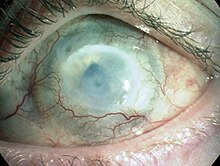| Chemical eye injury | |
|---|---|
| Other names | Chemical burns to the eye |
 | |
| An alkali burn to the human cornea can cause ocular surface failure with neovascularisation, opacification and blindness resulting from LESC deficiency. | |
| Specialty | Ophthalmology |
Chemical eye injury are due to either an acidic or alkali substance getting in the eye. Alkalis are typically worse than acidic burns. Mild burns will produce conjunctivitis while more severe burns may cause the cornea to turn white. Litmus paper is an easy way to rule out the diagnosis by verifying that the pH is within the normal range of 7.0—7.2. Large volumes of irrigation is the treatment of choice and should continue until the pH is 6–8. Local anesthetic eye drops can be used to decrease the pain.
Epidemiology
In the United States, chemical eye injuries most commonly occur among working-age adults. A 2016 analysis of emergency department visits from 2010 to 2013 reported over 36,000 visits annually for chemical burns to the eye, with a median age at presentation of 32 years. By individual year of age, 1- and 2-year-old children have the highest incidence of these injuries, with rates approximately 50% higher than the highest-risk adult group (25 years), and 13 times higher than the rate among 7-year-olds. Further research identified laundry detergent pods as a major source of injury among small children.
References
- ^ Zentani A, Burslem J (December 2009). "Towards evidence based emergency medicine: best BETs from the Manchester Royal Infirmary. BET 4: use of litmus paper in chemical eye injury". Emerg Med J. 26 (12): 887. doi:10.1136/emj.2009.086124. PMID 19934140. S2CID 38124735.
- ^ Hodge C, Lawless M (July 2008). "Ocular emergencies". Aust Fam Physician. 37 (7): 506–9. PMID 18592066.
- Saini JS, Sharma A (February 1993). "Ocular chemical burns-clinical and demographic profile". Burns. 19 (1): 67–69. doi:10.1016/0305-4179(93)90104-G. PMID 8435120.
- ^ Haring RS, Sheffield ID, Channa R, Canner JK, Schneider EB (August 2016). "Epidemiologic Trends of Chemical Ocular Burns in the United States". JAMA Ophthalmology. 134 (10): 1119–1124. doi:10.1001/jamaophthalmol.2016.2645. PMID 27490908.
- Haring, R. S.; Sheffield, I. D.; Frattaroli, S (2 February 2017). "Detergent Pod–Related Eye Injuries Among Preschool-Aged Children". JAMA Ophthalmology. 135 (3): 283–284. doi:10.1001/jamaophthalmol.2016.5694. PMID 28152145. S2CID 41092172.
This article about the eye is a stub. You can help Misplaced Pages by expanding it. |